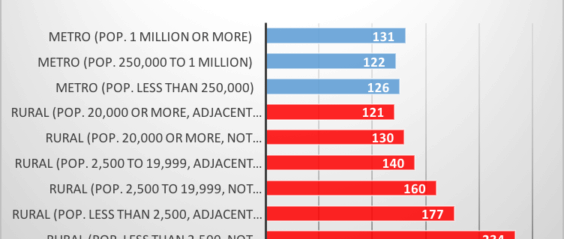The Next Evolution
Bill Frey at the Brookings Institute released a county-based analysis of the national election results based on the newly released 2016 U.S. Census data. The report is a good skim and provides a distinctive frame on political geography. A couple of highlights:
- One hundred seventy-seven million people live in counties carried by Hillary Clinton in 2016. 146 million people live in counties won by Donald Trump. In 2012, 180 million people lived in “Obama counties,” while 134 million people lived in “Romney counties.”
- In every election since 1992, including the Bush v. Gore election in 2000, more citizens lived in counties carried by the winning candidate than the losing candidates. In 2000, 149 million people lived in “Bush counties,” compared to 133 million in “Gore counties.”
In the Weeds
Two recent articles examine different perspectives on the public pension and retirement debates. The first, published by the Haas Institute at UC Berkeley, examines the accounting structure and funding goals for public pensions. Policy positions in the public pension space can be among the most diametrically opposed in government. This article does a nice job giving an accessible, technical overview of position points made by the more optimistic side.
A piece by Ramesh Ponnuru of the American Enterprise Institute examines the recent trend in some states to establish state-sponsored Individual Retirement Accounts (IRAs). Congress is evaluating whether to allow these programs, which were supported by the Obama Administration, and, if allowed, how to regulate them. The article provides an overview of the issue and ultimately suggests that they should be allowed but regulated as private, rather than public, retirement plans.
For Your Consideration
Bloomberg’s Megan McCardle wrote an interesting piece on how Utah has achieved relatively high levels of social mobility. In it, she digs into the characteristics that make Utah unique: cultural homogeneity, pervasive religious presence, and a distinctive social safety net. The article ends by considering whether Utah’s successes can be exported elsewhere and concludes that it might and that it would look something like George W. Bush’s compassionate conservatism.
Of note, North Carolina gets a shoutout: “The wide gulf between Utah and, say, North Carolina implies that we do, in fact, have a real problem on our hands. A child born in the bottom quintile of incomes in Charlotte has only a 4 percent chance of making it into the top quintile. A child in Salt Lake City, on the other hand, has more than a 10.8 percent chance — achingly close to the 11.7 percent found in Denmark and well on the way to the 20 percent chance you would expect in a perfectly just world.”
What we're reading
Four points and six charts that illustrate America's rural and urban divide
The 4 Points:1. Poverty is higher in rural areas
2. New jobs are not in rural areas
3. Disabilities are more common in rural areas
4. Rural areas are entrepreneurial... Read the rest
-
One reason young people don’t go into science? We don’t fail well
-
Education is Changing—It’s Time Assessment Caught Up
-
You Can Blame Pharmacy Benefit Managers for Higher Drug Prices
-
Can Religious Charities Take the Place of the Welfare State?
-
A Better (but Modest) Case for High-Risk Pools
-
Suburban Sprawl Stole Your Kids' Sleep


